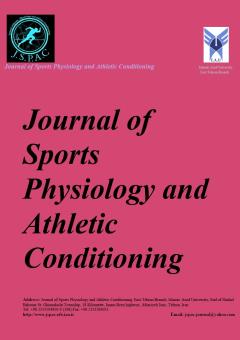The Relationship between Physical Fitness and Cardiac Waves in Volleyball Referees
الموضوعات : Sport Physiology
Saeedeh Zabihi
1
,
Rahim Shirazinejad
2
,
Ahmad Torkfar
3
,
Seyed Ali Hosseini
4
![]() ,
Mehrzad Moghadasi
5
,
Mehrzad Moghadasi
5
1 - Department of Exercise Management, Sh.C., Islamic Azad University, Shiraz, Iran
2 - Department of Exercise Management, Sh.C., Islamic Azad University, Shiraz, Iran
3 - Department of Exercise Management, Sh.C., Islamic Azad University, Shiraz, Iran
4 - Department of Exercise Physiology, Marv.C, Islamic Azad University, Marvdasht, Iran
5 - Department of exercise physiology, Sh.C. Islamic Azad University, Shiraz. Iran
الکلمات المفتاحية: Cardiac waves, physical fitness, volleyball,
ملخص المقالة :
Abstract
Background and Objective: In today’s professional world of refereeing, besides having specialized skills, capabilities, and personality traits, appropriate physical performance is one of the effective factors in sports advancement. The aim of the present study was to investigate the relationship between physical fitness and cardiac waves in volleyball referees.
Materials and Methods:
In this quasi-experimental comparative study, 60 volleyball referees from the national secondary school competitions for boys and girls (year 1402) were selected as the statistical sample. On the first day of the competitions, after the opening session, the research process, along with the benefits and strengths of participation, was explained to all referees in a predetermined meeting, and volunteer registration was conducted. On the following day, demographic questionnaires were first distributed among the volunteer referees, collected after completion, and then cardiac waves were measured using an electrocardiogram device. Additionally, to assess physical fitness, the factors of flexibility, muscular endurance, body mass index (BMI), and waist-to-hip ratio were measured. For inferential data analysis, Pearson’s correlation coefficient test was used (P ≤ 0.05).
Results:
There was a significant correlation between the P wave and flexibility (P = 0.02) and waist-to-hip ratio (P = 0.01); between the PQ interval and flexibility (P = 0.01) and muscular endurance (P = 0.004); and between the QT interval and muscular endurance (P = 0.02).
Discussion:
It appears that in volleyball referees, with improved physical fitness, cardiac function also improves.
References
1. Alimohammadzadeh K, Akhlaghdoust M, Bahrainian SA, Mirzaei A. (2017). Survey on Mental Health of Iranian Medical Students: A Cross -sectional Study in Islamic Azad University. Shiraz E -Med J 2017;18: e14929 .
2. Li WW, Xie G. (2020) Personality and job satisfaction among Chinese health practitioners: The mediating role of professional quality of life. Health Psychol Open 2020;7:2055102920965053.
3. Esmaeil Zarghami, Milad Olfat. Relationship between physical and mental health, and different housing types for elderly. Payesh 2017; 16 (4) :521-530
4. Alavi M, Jorjoran Shushtari Z, Noroozi M, Mohammadi Shahboulaghi F. Mental Health and Related Factors in Old Population in Tehran 2014-2015. J Mazandaran Univ Med Sci 2018; 27 (158) :112-122
5. Fusar-Poli, P., de Pablo, G. S., De Micheli, A., Nieman, D. H., Correll, C. U., Kessing, L. V., & van Ame lsvoort, T. (2020). What is good mental health? A scoping review. European Neuro psycho pharmacology, 31, 33-46.
6. Lee, H. J., & Lee, D. K. (2019). Do sociodemographic factors and urban green space affect mental health outcomes among the urban elderly population? International Journal of Environmental Research and Public Health, 16(5), Article 789.
7. Samadi, H., Moradi, J., & Ahar, S. (2022). Psychometric Properties of the Persian Version of Referee SelfEfficacy Scale (REFS). Journal of Sports and Motor Development and Learning, 14(2), 69-86.
8. Hanin, Y.L. (2000).Emotions in sport. Champaign. Behavior Modification, (29), 616-641.
9. Khosravi, Shirin, Haghayegh, Sayed Abbas. (2018). Comparison of personality characteristics and personality types of contact and non- contact sport majors. Knowledge & Research in Applied Psychology. 4: 21-34.
10. Mangeshti Y, Sayadi MA, Kashef M. Investigating the relationship between personality traits and self-control factors of male referees in the Premier League.2017; 26 (9): 101- 122.
11. kamali, F. , manochehri Nezhad, M. and hakak zadeh, M. (2021). Designing an Ethical Decision-Making Model for Professional Football Referees in Iran. Sport Psychology Studies, 9(34), 235-258. doi: 10.22089/spsyj.2020.9405.2030.
12. delfani Z, Ghyratmand R. Comparison of functional changes in the heart and QTc intervals in a maximal and isotonic isometric exercise activity in active and inactive men. Research in Medicine 2019; 43 (4) :228-233.
13. Razi K, Hosseini S A, Shadmehri S, Salehi O R, Ahmadi M, et al. Interactive Effects of Aerobic Exercise and Music on Electrical Activity of the Heart in Non-Athletic Men.Mod Care J.2019;17(1):e97858.
14. Turkmen M, Barutcu I, Esen AM, Ocak Y, Melek M, Kaya D, et al. Assessment of QT interval duration and dispersion in athlete’s heart. Journal of International Medical Research. 2004; 32(6):626-32.
15. Prakash K, Sharma S. Interpretation of the Electrocardiogram in Athletes. Canadian Journal of Cardiology. 2016; 32(4):438-51.
16. Abad CCC, do Nascimento AM, dos Santos LE, Figueroa D, Ramona P, Sartori M, et al. Interval and continuous aerobic exercise training similarly increase cardiac function and autonomic modulation in infarcted mice. Journal of Exercise Rehabilitation. 2017; 13(3):257-65.
17. Salehi. H, Mohseni. M (2017), Level of Anxiety of Iranian Referees: Selfawareness and Conflict Styles, Quarterly Journal of Sport Management and Motor Behavioral Management, No. 14,: 25-15.
18. Arch, J. J., Ayers, C. R., Baker, A., Almklov, E., Dean, D. J., & Craske, M. G. (2013). Randomized clinical trial of adapted mindfulness-based stress reduction versus group cognitive behavioral therapy for heterogeneous anxiety disorders. Behaviour research and therapy, 51(4-5), 185-196.
19. Nikbakhsh, R., Alam, S., & Monazami, M. (2013). The relationship between emotional intelligence, communication skills and stress among Iranian premier league referees. Annals of Biological Research, 4(4), 196-203.
20. Nabli, M. A., Abdelkrim, N. B., Jabri, I., Batikh, T., Castagna, C., & Chamari, K. (2016). Fitness Field Tests’ Correlation with Game Performance in U-19-Category Basketball Referees. International journal of sports physiology and performance, 11(8), 1005-1011.


